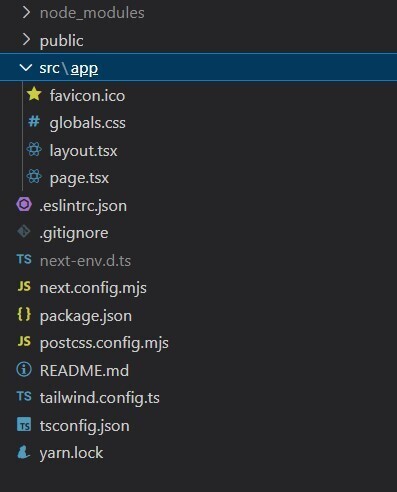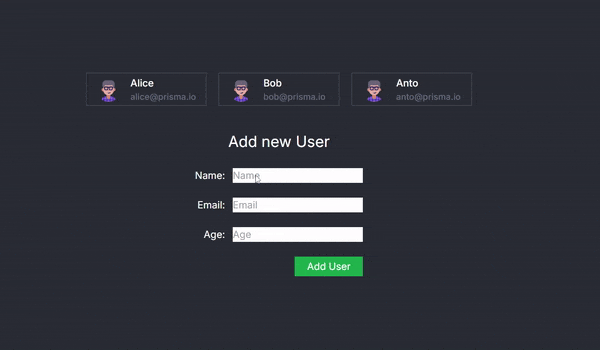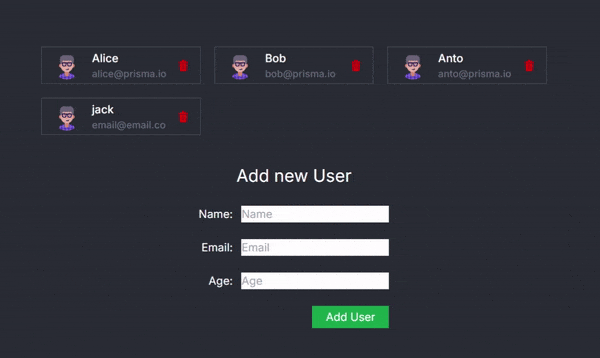React - Ações do Servidor
React form Actions.
React has introduced new form Actions and related hooks to enhance native forms and streamline client-server communication. These features enable developers to handle form submissions more effectively, improving both user experience and code maintainability. For an in-depth exploration of React form Actions, you can refer to my detailed post on my post about React Form Actions.
Server Actions
With React 18, the Server Components feature was introduced. Server components are not Server-Side Rendering (SSR), Server Components are executed exclusively on the server during both runtime and build time. These components can access server-side resources, such as databases and the file system, but they are not capable of performing client-side actions like event listeners or hooks.
Prerequisites
To demonstrate the capabilities of Server Components and Server Actions, we'll use Next.js and Prisma.
Next.js is a React framework for building full-stack web applications. You use React Components to build user interfaces, and Next.js for additional features and optimizations. Under the hood, Next.js also abstracts and automatically configures tooling needed for React, like bundling, compiling, and more. This allows you to focus on building your application instead of spending time with configuration. learn more
Prisma is an ORM that simplifies database access and operations, allowing you to query and manipulate data without writing SQL. Learn more
Initial Setup
Start by creating a new Next.js application:
yarn create next-app server-example
Your initial folder structure will look like this:

Upgrade to the Canary Release to access React 19 features, including Server Actions:
yarn add next@rc react@rc react-dom@rc
install Prisma
yarn add prisma
Prisma Configuration
Create a Prisma schema file at src/lib/prisma/schema.prisma:
generator client {
provider = "prisma-client-js"
}
datasource db {
provider = "sqlite"
url = "file:./dev.db"
}
model User {
id Int @id @default(autoincrement())
email String @unique
name String?
age Int
}
For demonstration purposes, we are using SQLite. For production, you should use a more robust database.
Next, add a Prisma client file at src/lib/prisma/prisma.ts
// ts-ignore 7017 is used to ignore the error that the global object is not
// defined in the global scope. This is because the global object is only
// defined in the global scope in Node.js and not in the browser.
import { PrismaClient } from '@prisma/client'
// PrismaClient is attached to the `global` object in development to prevent
// exhausting your database connection limit.
//
// Learn more:
// https://pris.ly/d/help/next-js-best-practices
const globalForPrisma = global as unknown as { prisma: PrismaClient }
export const prisma = globalForPrisma.prisma || new PrismaClient()
if (process.env.NODE_ENV !== 'production') globalForPrisma.prisma = prisma
export default prisma
Configure Prisma in package.json:
{
//other settings
"prisma": {
"schema": "src/lib/prisma/schema.prisma",
"seed": "ts-node src/lib/prisma/seed.ts"
}
}
And update TypeScript settings in tsconfig.json:
{
//Other settings here...
"ts-node": {
// these options are overrides used only by ts-node
// same as the --compilerOptions flag and the
// TS_NODE_COMPILER_OPTIONS environment variable
"compilerOptions": {
"module": "commonjs"
}
}
}
Install ts-node globally:
yarn global add ts-node
Seeding Initial Data
Add a seed file at src/lib/prisma/seed.ts to populate initial data:
import { PrismaClient } from "@prisma/client";
const prisma = new PrismaClient();
async function main() {
await prisma.user.create({
email: "[email protected]",
name: "Anto",
age: 35,
});
await prisma.user.create({
email: "[email protected]",
name: "Vinish",
age: 32,
});
}
main()
.then(async () => {
await prisma.$disconnect();
})
.catch(async (e) => {
console.error(e);
await prisma.$disconnect();
process.exit(1);
});
Install Prisma client
yarn add @prisma/client
Run the migration command:
yarn prisma migrate dev --name init
If the seed data is not reflected, add it manually:
yarn prisma db seed
Great! Since the installations are ready, you can create an actions file that performs database operations.
Creating Server Actions
Server Actions are a powerful feature that enables seamless client-server intercommunication. Let's create a file for database operations at src/actions/user.ts:
"use server";
import prisma from '@/lib/prisma/prisma'
import { revalidatePath } from "next/cache";
// export type for user
export type User = {
id: number;
name: string | null;
email: string;
age: number;
};
export async function createUser(user: any) {
const resp = await prisma.user.create({ data: user });
console.log("server Response");
revalidatePath("/");
return resp;
}
export async function getUsers() {
return await prisma.user.findMany();
}
export async function deleteUser(id: number) {
await prisma.user.delete({
where: {
id: id,
},
});
revalidatePath("/");
}
Implementing Server Components
Let's create a React server component to read and render data from the database. Create src/app/serverexample/page.tsx:
import UserList from "./Users";
import "./App.css"
export default async function ServerPage() {
return (
Add some styling in src/app/serverexample/App.css
.App {
text-align: center;
}
.App-logo {
height: 40vmin;
pointer-events: none;
}
.App-header {
background-color: #282c34;
min-height: 100vh;
display: flex;
flex-direction: column;
align-items: center;
justify-content: center;
font-size: calc(10px 2vmin);
color: white;
}
input {
color: #000;
}
.App-link {
color: #61dafb;
}
Create components to fetch and render the user list:
src/app/serverexample/UserList.tsx
import { getUsers } from "@/actions/user";
import { UserDetail } from "./UserDetail";
export default async function UserList() {
//Api call to fetch User details
const users = await getUsers();
return (
{users.length ? (
users.map((user) =>
src/app/serverexample/UserDetail.tsx
export function UserDetail({ user }) {
return (
 {user.name}
{user.email}
);
}
{user.name}
{user.email}
);
}
Run the development server:
yarn dev
Navigate to http://localhost:3000/serverexample to see the rendered user list:
By default, components in Next.js are server components unless you specify the "use client" directive. Notice two important points:
- Async Component Definition: Server components can be asynchronous as they do not re-render and are only generated once.
- Data Fetching: The line const users = await getUsers(); fetches data from the server and renders it at runtime.
Exploring Server Actions
Server Actions enable seamless client-server intercommunication. Let's add a form to create new users.
Create a new file at src/app/serverexample/AddUser.tsx:
"use client";
import "./app.css";
import { useActionState } from "react";
import { createUser } from "../../actions/user";
const initialState = {
error: undefined,
};
export default function AddUser() {
const submitHandler = async (_previousState: object, formData: FormData) => {
try {
// This is the Server Action method that transfers the control
// Back to the server to do DB operations and get back the result.
const response = await createUser({
name: formData.get("name") as string,
email: formData.get("email") as string,
age: parseInt(formData.get("age") as string),
});
return { response };
} catch (error) {
return { error };
}
};
const [state, submitAction, isPending] = useActionState(
submitHandler,
initialState
);
return (
Add new User
{" "}
);
}
Update src/app/serverexample/page.tsx to include the AddUser component:
import UserList from "./UserList";
// Import new line
import AddUser from "./AddUser";
import "./App.css"
export default async function ServerPage() {
return (
Running the application will now allow you to add new users via the form, with server-side processing handled seamlessly.
The AddUser Component and Seamless Client-Server Interaction
The AddUser component is at the heart of this example, showcasing how React Server Actions can revolutionize the way we handle client-server interactions. This component renders a form for adding new users and leverages the useActionState hook to create a smooth and seamless bridge between the client-side interface and server-side operations.
How It Works
- Form Rendering and Data Handling:
- The AddUser component provides a form where users can input their name, email, and age.
- Upon form submission, the data is captured and prepared to be sent to the server.
- useActionState Hook:
- The useActionState hook is a crucial part of this setup. It simplifies the complexity of managing client-side state and server-side actions by abstracting them into a unified interface.
- This hook accepts an asynchronous handler function, which processes the form data and then calls a Server Action method.
- The brilliance of this approach lies in its abstraction: it feels as though you’re invoking a regular function within the same file, even though it actually triggers a server-side operation.
- Server Action Method:
- The createUser function, defined as a Server Action, executes on the server side. It takes the user data from the form, performs the necessary database operations via Prisma, and returns the result.
- This server-side method is crucial for maintaining a clean separation between the client and server, while still enabling them to communicate effectively.
- Seamless Integration:
From the perspective of a developer working on the client side, it appears as if the form submission is handled locally. However, the heavy lifting such as database manipulation occurs on the server.
The useActionState hook encapsulates this process, managing the state transitions and handling errors, while maintaining an intuitive API for developers.
Server Actions Without Forms
So that's with forms, now lets test an example without forms.
update src/app/serverexample/UserDetail.tsx
"use client";
import { deleteUser } from "@/actions/user";
import { useTransition } from "react";
export function UserDetail({ user }) {
const [pending, startTransition] = useTransition();
const handleDelete = () => {
startTransition(() => {
deleteUser(user.id);
});
};
return (
{pending ? (
Deleting...
) : (
 {user.name}
{user.email}
>
)}
);
}
{user.name}
{user.email}
>
)}
);
}
Key Points:
- Server Action: deleteUser(user.id) is a server action that removes the user from the database. This operation is triggered without any form submission.
- useTransition: This hook allows you to manage the asynchronous state of the deletion process, showing a "Deleting..." message while the operation is in progress.
- User Interface: The component maintains a clean UI, dynamically updating based on the action status.
Now, you can seamlessly delete a user within the application:
Conclusion
This approach is transformative because it abstracts away the complexities of client-server communication. Traditionally, such interactions would require handling API endpoints, managing asynchronous requests, and carefully coordinating client-side state with server responses. With React Server Actions and the useActionState hook, this complexity is reduced, allowing developers to focus more on building features rather than worrying about the underlying infrastructure.
By using this pattern, you gain:
- Cleaner Code: The client-side code remains simple and focused, without the need for explicit API calls.
- Improved Developer Experience: Server-side operations are seamlessly integrated, reducing cognitive load and potential for errors.
- Enhanced Performance: Server Actions are optimized for performance, reducing unnecessary client-server round trips and ensuring that server-side resources are used efficiently.
You can find the full code in the repository
-
 Gerenciamento eficaz de versões de modelos em projetos de aprendizado de máquinaEm projetos de aprendizado de máquina (ML), um dos componentes mais críticos é o gerenciamento de versões. Ao contrário do desenvolvimento de software...Programação Publicado em 2024-11-06
Gerenciamento eficaz de versões de modelos em projetos de aprendizado de máquinaEm projetos de aprendizado de máquina (ML), um dos componentes mais críticos é o gerenciamento de versões. Ao contrário do desenvolvimento de software...Programação Publicado em 2024-11-06 -
 Como agrupar matrizes associativas por valor de coluna enquanto preserva chaves em PHP?Agrupando matrizes associativas por valor de coluna enquanto preserva chavesConsidere uma matriz de matrizes associativas, cada uma representando uma ...Programação Publicado em 2024-11-06
Como agrupar matrizes associativas por valor de coluna enquanto preserva chaves em PHP?Agrupando matrizes associativas por valor de coluna enquanto preserva chavesConsidere uma matriz de matrizes associativas, cada uma representando uma ...Programação Publicado em 2024-11-06 -
 Como excluir dependências transitivas específicas no Gradle?Excluindo dependências transitivas com GradleNo Gradle, ao usar o plugin do aplicativo para gerar um arquivo jar, é possível encontrar dependências tr...Programação Publicado em 2024-11-06
Como excluir dependências transitivas específicas no Gradle?Excluindo dependências transitivas com GradleNo Gradle, ao usar o plugin do aplicativo para gerar um arquivo jar, é possível encontrar dependências tr...Programação Publicado em 2024-11-06 -
 A ARTE DE VIVER MINIMALISTAO que é vida minimalista? A vida minimalista é um estilo de vida em que você reduz intencionalmente o número de bens que possui e a quantidad...Programação Publicado em 2024-11-06
A ARTE DE VIVER MINIMALISTAO que é vida minimalista? A vida minimalista é um estilo de vida em que você reduz intencionalmente o número de bens que possui e a quantidad...Programação Publicado em 2024-11-06 -
 Quebra-cabeça de ofuscação JavaCome play with our Java Obfuscator & try to deobfuscate this output. The price is the free activation code! Obfuscated Java code Your goal...Programação Publicado em 2024-11-06
Quebra-cabeça de ofuscação JavaCome play with our Java Obfuscator & try to deobfuscate this output. The price is the free activation code! Obfuscated Java code Your goal...Programação Publicado em 2024-11-06 -
 Como criar cantos arredondados em e-mails do Outlook sem imagens?Estilizando cantos arredondados no Outlook sem imagensCriar cantos arredondados em clientes de e-mail pode ser simples usando CSS. No entanto, o métod...Programação Publicado em 2024-11-06
Como criar cantos arredondados em e-mails do Outlook sem imagens?Estilizando cantos arredondados no Outlook sem imagensCriar cantos arredondados em clientes de e-mail pode ser simples usando CSS. No entanto, o métod...Programação Publicado em 2024-11-06 -
 Como comparar dicionários com eficiência para pares de valores-chave iguais em Python?Comparando dicionários para pares de valores-chave iguaisEm Python, comparar dicionários para verificar se pares de valores-chave são iguais é uma tar...Programação Publicado em 2024-11-06
Como comparar dicionários com eficiência para pares de valores-chave iguais em Python?Comparando dicionários para pares de valores-chave iguaisEm Python, comparar dicionários para verificar se pares de valores-chave são iguais é uma tar...Programação Publicado em 2024-11-06 -
 Como girar os elementos do array para a esquerda no PHP usando funções de array?Rotação dos elementos do array à esquerda no PHPRotação de um array no PHP, movendo o primeiro elemento para o último e reindexando o array, pode ser ...Programação Publicado em 2024-11-06
Como girar os elementos do array para a esquerda no PHP usando funções de array?Rotação dos elementos do array à esquerda no PHPRotação de um array no PHP, movendo o primeiro elemento para o último e reindexando o array, pode ser ...Programação Publicado em 2024-11-06 -
 Como resolver o erro “O sistema não consegue encontrar o caminho especificado” ao acessar arquivos em Java?Resolvendo problemas de caminho de arquivo em Java ao encontrar "O sistema não consegue encontrar o caminho especificado"Em seu projeto Java...Programação Publicado em 2024-11-06
Como resolver o erro “O sistema não consegue encontrar o caminho especificado” ao acessar arquivos em Java?Resolvendo problemas de caminho de arquivo em Java ao encontrar "O sistema não consegue encontrar o caminho especificado"Em seu projeto Java...Programação Publicado em 2024-11-06 -
 Como funciona a função defer() no Laravel?Taylor Otwell anunciou recentemente a nova função no Laravel chamada defer(). Isso fornecerá apenas uma visão geral básica de como a função defer() fu...Programação Publicado em 2024-11-06
Como funciona a função defer() no Laravel?Taylor Otwell anunciou recentemente a nova função no Laravel chamada defer(). Isso fornecerá apenas uma visão geral básica de como a função defer() fu...Programação Publicado em 2024-11-06 -
 Explorando operações de dados com PySpark, Pandas, DuckDB, Polars e DataFusion em um notebook PythonApache Iceberg Crash Course: What is a Data Lakehouse and a Table Format? Free Copy of Apache Iceberg the Definitive Guide Free Apache Iceberg Crash ...Programação Publicado em 2024-11-06
Explorando operações de dados com PySpark, Pandas, DuckDB, Polars e DataFusion em um notebook PythonApache Iceberg Crash Course: What is a Data Lakehouse and a Table Format? Free Copy of Apache Iceberg the Definitive Guide Free Apache Iceberg Crash ...Programação Publicado em 2024-11-06 -
 Vue + Tailwind e aulas dinâmicasUm projeto em que venho trabalhando recentemente faz uso de Vite, Vue e Tailwind. Depois de algum tempo trabalhando com cores personalizadas, enfrent...Programação Publicado em 2024-11-06
Vue + Tailwind e aulas dinâmicasUm projeto em que venho trabalhando recentemente faz uso de Vite, Vue e Tailwind. Depois de algum tempo trabalhando com cores personalizadas, enfrent...Programação Publicado em 2024-11-06 -
 Ponta a ponta (teste E: um guia abrangenteIntrodução aos testes ponta a ponta O teste ponta a ponta (E2E) é uma parte crucial do ciclo de vida de desenvolvimento de software, garantindo que t...Programação Publicado em 2024-11-06
Ponta a ponta (teste E: um guia abrangenteIntrodução aos testes ponta a ponta O teste ponta a ponta (E2E) é uma parte crucial do ciclo de vida de desenvolvimento de software, garantindo que t...Programação Publicado em 2024-11-06 -
 Você pode usar variáveis em tags Go Struct?Incorporando variáveis em tags de estrutura GoAs tags de estrutura de Go, frequentemente usadas para anotações e metadados, geralmente envolvem lite...Programação Publicado em 2024-11-06
Você pode usar variáveis em tags Go Struct?Incorporando variáveis em tags de estrutura GoAs tags de estrutura de Go, frequentemente usadas para anotações e metadados, geralmente envolvem lite...Programação Publicado em 2024-11-06 -
 Como aprimorar a verbosidade de compilação do Visual Studio para obter insights aprofundados?Conhecendo a verbosidade de compilação do Visual StudioPrecisa de uma compreensão abrangente dos detalhes intrincados por trás do processo de compilaç...Programação Publicado em 2024-11-06
Como aprimorar a verbosidade de compilação do Visual Studio para obter insights aprofundados?Conhecendo a verbosidade de compilação do Visual StudioPrecisa de uma compreensão abrangente dos detalhes intrincados por trás do processo de compilaç...Programação Publicado em 2024-11-06
Estude chinês
- 1 Como se diz “andar” em chinês? 走路 Pronúncia chinesa, 走路 aprendizagem chinesa
- 2 Como se diz “pegar um avião” em chinês? 坐飞机 Pronúncia chinesa, 坐飞机 aprendizagem chinesa
- 3 Como se diz “pegar um trem” em chinês? 坐火车 Pronúncia chinesa, 坐火车 aprendizagem chinesa
- 4 Como se diz “pegar um ônibus” em chinês? 坐车 Pronúncia chinesa, 坐车 aprendizagem chinesa
- 5 Como se diz dirigir em chinês? 开车 Pronúncia chinesa, 开车 aprendizagem chinesa
- 6 Como se diz nadar em chinês? 游泳 Pronúncia chinesa, 游泳 aprendizagem chinesa
- 7 Como se diz andar de bicicleta em chinês? 骑自行车 Pronúncia chinesa, 骑自行车 aprendizagem chinesa
- 8 Como você diz olá em chinês? 你好Pronúncia chinesa, 你好Aprendizagem chinesa
- 9 Como você agradece em chinês? 谢谢Pronúncia chinesa, 谢谢Aprendizagem chinesa
- 10 How to say goodbye in Chinese? 再见Chinese pronunciation, 再见Chinese learning

























